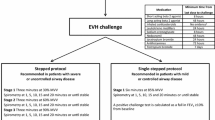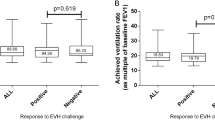Abstract
Introduction
Exercise-induced bronchoconstriction (EIB) is very common in athletes. Cardiopulmonary exercise tests (CPET) have traditionally been used for the diagnosis of EIB. However, alternative indirect bronchoprovocation tests have recently been used as surrogate tests. One of these is the eucapnic voluntary hyperventilation (EVH). This meta-analysis studied the agreement between the two tests.
Methods
An extensive search in PubMed and Medline was conducted for studies where participants underwent both CPET and EVH with measurement of forced expiratory volume in 1-second (FEV1). After extracting data using two-by-two contingency tables, pooled positive and negative agreements were first calculated between the two tests, with EVH benchmarked against CPET, and then, pooled positive and negative agreements were calculated with CPET benchmarked against EVH.
Results
The pooled positive and negative agreements between EVH and CPET (with CPET as the reference) were 0.62 [(95% confidence interval 0.54–0.70), I2 77%] and 0.61 [(0.56–0.65)), I2 81%]. The pooled positive and negative agreements between CPET and EVH (with EVH as the reference) were 0.36 [(0.30–0.42), I2 93%] and 0.82 [(0.77–0.86), I2 78%]. The average of positive test results with EVH across all studies was greater than that of CPETs (58.84% vs. 39.51%).
Conclusions
Results of this meta-analysis show poor positive agreement between the two tests but high negative agreement (specifically using EVH as reference), suggesting that either test can be used for correctly identifying those without EIB. Results also suggest that the chances of a test resulting positive are higher with EVH than with CPET.





Similar content being viewed by others
References
Weiler JM, Anderson SD, Randolph C, Bonini S, Craig TJ, Pearlman DS, Rundell KW, Silvers WS, Storms WW, Bernstein DI et al (2010) Pathogenesis, prevalence, diagnosis, and management of exercise-induced bronchoconstriction: a practice parameter. Ann Allergy Asthma Immunol 105:S1–47
Price OJ, Hull JH, Backer V, Hostrup M, Ansley L (2014) The impact of exercise-induced bronchoconstriction on athletic performance: a systematic review. Sports Med 44:1749–1761
Parsons JP (2014) Exercise-induced bronchoconstriction. Otolaryngol Clin North Am 47:119–126
van Leeuwen JC, Driessen JM, Kersten ET, Thio BJ (2013) Assessment of exercise-induced bronchoconstriction in adolescents and young children. Immunol Allergy Clin North Am 33:381–394
Ansley L, Kippelen P, Dickinson J, Hull JH (2012) Misdiagnosis of exercise-induced bronchoconstriction in professional soccer players. Allergy 67:390–395
Lund TK, Pedersen L, Anderson SD, Sverrild A, Backer V (2009) Are asthma-like symptoms in elite athletes associated with classical features of asthma? Br J Sports Med 43:1131–1135
Rundell KW, Im J, Mayers LB, Wilber RL, Szmedra L, Schmitz HR (2001) Self-reported symptoms and exercise-induced asthma in the elite athlete. Med Sci Sports Exerc 33:208–213
Bonini M, Lapucci G, Petrelli G, Todaro A, Pamich T, Rasi G, Bonini S (2007) Predictive value of allergy and pulmonary function tests for the diagnosis of asthma in elite athletes. Allergy 62:1166–1170
Parsons JP, Hallstrand TS, Mastronarde JG, Kaminsky DA, Rundell KW, Hull JH, Storms WW, Weiler JM, Cheek FM, Wilson KC et al (2013) An official American Thoracic Society clinical practice guideline: exercise-induced bronchoconstriction. Am J Respir Crit Care Med 187:1016–1027
Rosenthal RR (1984) Simplified eucapnic voluntary hyperventilation challenge. J Allergy Clin Immunol 73:676–679
Anderson SD, Argyros GJ, Magnussen H, Holzer K (2001) Provocation by eucapnic voluntary hyperpnoea to identify exercise induced bronchoconstriction. Br J Sports Med 35:344–347
Whiting PF, Rutjes AW, Westwood ME, Mallett S, Deeks JJ, Reitsma JB, Leeflang MM, Sterne JA, Bossuyt PM (2011) Group Q-: QUADAS-2: a revised tool for the quality assessment of diagnostic accuracy studies. Ann Intern Med 155:529–536
Moher D, Liberati A, Tetzlaff J, Altman DG, Group P (2009) Preferred reporting items for systematic reviews and meta-analyses: the PRISMA statement. J Clin Epidemiol 62:1006–1012
USFDA (2007) Statistical guidance on reporting results from studies evaluating diagnostic tests. https://www.fda.gov/RegulatoryInformation/Guidances/ucm071148.htm. Accessed 15 April 2018
Freeman K, Tsertsvadze A, Taylor-Phillips S, McCarthy N, Mistry H, Manuel R, Mason J (2017) Agreement between gastrointestinal panel testing and standard microbiology methods for detecting pathogens in suspected infectious gastroenteritis: test evaluation and meta-analysis in the absence of a reference standard. PLoS ONE 12:e0173196
Castricum A, Holzer K, Brukner P, Irving L (2010) The role of the bronchial provocation challenge tests in the diagnosis of exercise-induced bronchoconstriction in elite swimmers. Br J Sports Med 44:736–740
Chateaubriand do Nascimento Silva Filho MJ, Goncalves AV, Tavares Viana M, Peixoto DM, Cavalcanti Sarinho ES, Rizzo JA (2015) Exercise-induced bronchoconstriction diagnosis in asthmatic children: comparison of treadmill running and eucapnic voluntary hyperventilation challenges. Ann Allergy Asthma Immunol 115:277–281
Dickinson JW, Whyte GP, McConnell AK, Harries MG (2006) Screening elite winter athletes for exercise induced asthma: a comparison of three challenge methods. Br J Sports Med 40:179–182 (discussion 179–182)
Eliasson AH, Phillips YY, Rajagopal KR, Howard RS (1992) Sensitivity and specificity of bronchial provocation testing. An evaluation of four techniques in exercise-induced bronchospasm. Chest 102:347–355
Pedersen L, Winther S, Backer V, Anderson SD, Larsen KR (2008) Airway responses to eucapnic hyperpnea, exercise, and methacholine in elite swimmers. Med Sci Sports Exerc 40:1567–1572
Rundell KW, Anderson SD, Spiering BA, Judelson DA (2004) Field exercise vs laboratory eucapnic voluntary hyperventilation to identify airway hyperresponsiveness in elite cold weather athletes. Chest 125:909–915
Schmidt A, Bach-Mortensen N, Bundgaard A (1983) Comparison of isocapnic hyperventilation and treadmill exercise in children with exercise-induced asthma. Scand J Clin Lab Invest 43:203–206
AlbuquerqueRodriguesFilho E, Rizzo JA, Goncalves AV, CorreiaJunior MAV, Sarinho ESC, Medeiros D (2018) Exercise-induced bronchospasm in children and adolescents with allergic rhinitis by treadmill and hyperventilation challenges. Respir Med 138:102–106
Fitch KD, Sue-Chu M, Anderson SD, Boulet LP, Hancox RJ, McKenzie DC, Backer V, Rundell KW, Alonso JM, Kippelen P et al (2008) Asthma and the elite athlete: summary of the International Olympic Committee's consensus conference, Lausanne, Switzerland, January 22–24, 2008. J Allergy Clin Immunol 122:254–260
Parsons JP, Kaeding C, Phillips G, Jarjoura D, Wadley G, Mastronarde JG (2007) Prevalence of exercise-induced bronchospasm in a cohort of varsity college athletes. Med Sci Sports Exerc 39:1487–1492
Dryden DM, Spooner CH, Stickland MK, Vandermeer B, Tjosvold L, Bialy L, Wong K, Rowe BH (2010) Exercise-induced bronchoconstriction and asthma. Evid Rep Technol Assess (Full Rep) 189:1–154
Anderson SD, Lambert S, Brannan JD, Wood RJ, Koskela H, Morton AR, Fitch KD (2001) Laboratory protocol for exercise asthma to evaluate salbutamol given by two devices. Med Sci Sports Exerc 33:893–900
Bougault V, Turmel J, Levesque B, Boulet LP (2009) The respiratory health of swimmers. Sports Med 39:295–312
McFadden ER Jr, Nelson JA, Skowronski ME, Lenner KA (1999) Thermally induced asthma and airway drying. Am J Respir Crit Care Med 160:221–226
Funding
This study was not sponsored by any funding agency or pharmaceutical company.
Author information
Authors and Affiliations
Contributions
IHI had full access to all of the extracted data in the network meta-analysis and takes responsibility for the integrity of the data and the accuracy of the data analysis. IHI conceptualized and designed the study protocol, conducted the analyses, and wrote the first draft manuscript. IHI and MG contributed to assessment of study quality. All authors contributed substantially to the interpretation of analyses and in revisions of manuscript.
Corresponding author
Ethics declarations
Conflicts of interest
The authors declare that they have no conflicts of interest.
Additional information
Publisher’s Note
Springer Nature remains neutral with regard to jurisdictional claims in published maps and institutional affiliations.
Electronic supplementary material
Below is the link to the electronic supplementary material.
Rights and permissions
About this article
Cite this article
Iftikhar, I.H., Greer, M. & Jaiteh, A. A Meta-analysis of Diagnostic Test Agreement Between Eucapnic Voluntary Hyperventilation and Cardiopulmonary Exercise Tests for Exercise-Induced Bronchoconstriction. Lung 197, 483–492 (2019). https://doi.org/10.1007/s00408-019-00233-4
Received:
Accepted:
Published:
Issue Date:
DOI: https://doi.org/10.1007/s00408-019-00233-4




